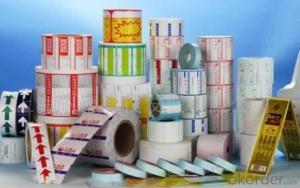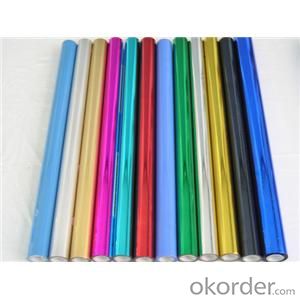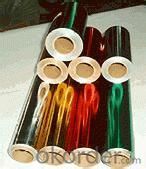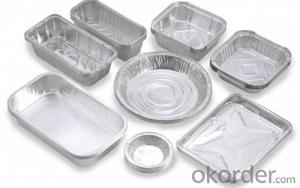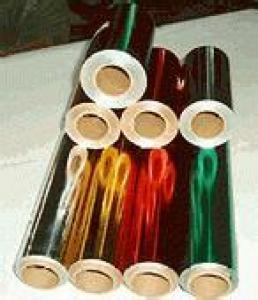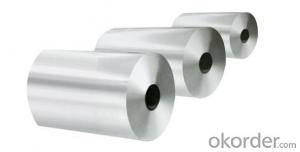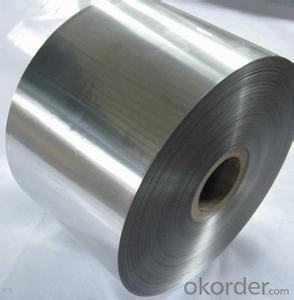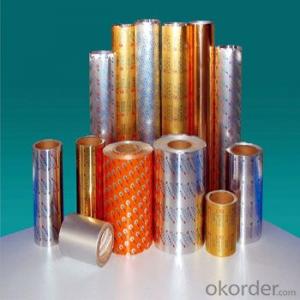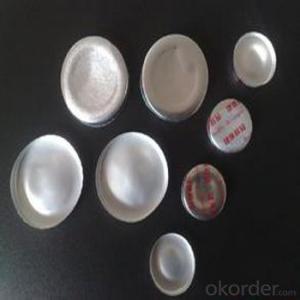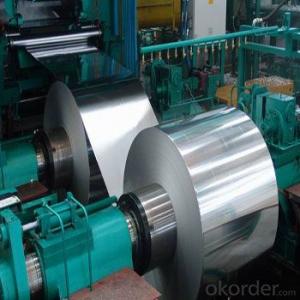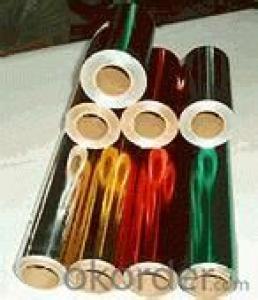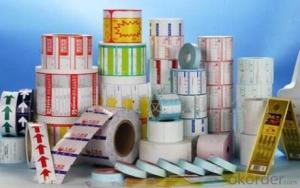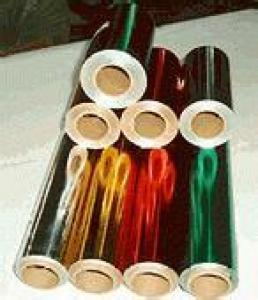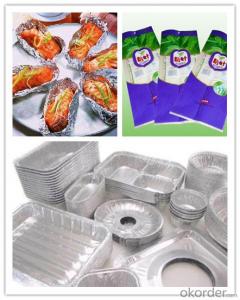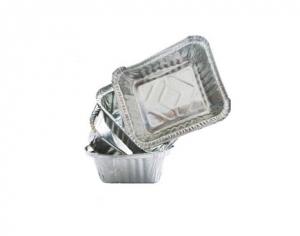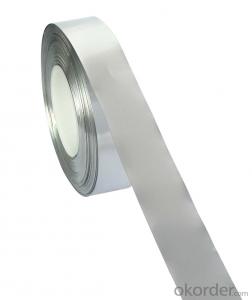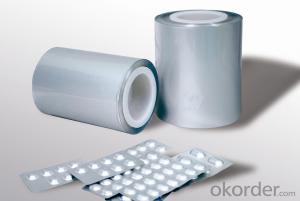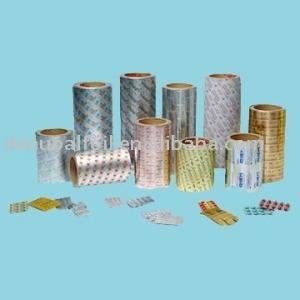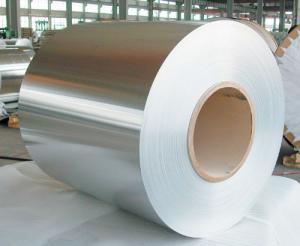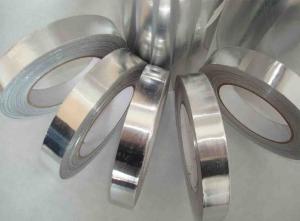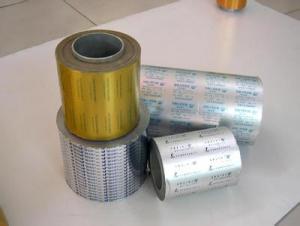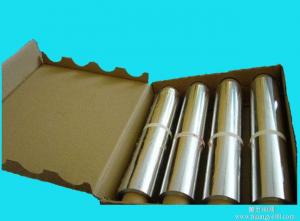Heb Texas Tough Aluminum Foil for Alcohol Sign
- Loading Port:
- China Main Port
- Payment Terms:
- TT OR LC
- Min Order Qty:
- -
- Supply Capability:
- -
OKorder Service Pledge
OKorder Financial Service
You Might Also Like
Aluminium alloys with a wide range of properties are used in engineering structures. Alloy systems are classified by a number system (ANSI) or by names indicating their main alloying constituents (DIN and ISO).
The strength and durability of aluminium alloys vary widely, not only as a result of the components of the specific alloy, but also as a result of heat treatments and manufacturing processes. A lack of knowledge of these aspects has from time to time led to improperly designed structures and gained aluminium a bad reputation.
One important structural limitation of aluminium alloys is their fatigue strength. Unlike steels, aluminium alloys have no well-defined fatigue limit, meaning that fatigue failure eventually occurs, under even very small cyclic loadings. This implies that engineers must assess these loads and design for a fixed life rather than an infinite life.
Another important property of aluminium alloys is their sensitivity to heat. Workshop procedures involving heating are complicated by the fact that aluminium, unlike steel, melts without first glowing red. Forming operations where a blow torch is used therefore require some expertise, since no visual signs reveal how close the material is to melting. Aluminium alloys, like all structural alloys, also are subject to internal stresses following heating operations such as welding and casting. The problem with aluminium alloys in this regard is their low melting point, which make them more susceptible to distortions from thermally induced stress relief. Controlled stress relief can be done during manufacturing by heat-treating the parts in an oven, followed by gradual cooling—in effect annealing the stresses.
The low melting point of aluminium alloys has not precluded their use in rocketry; even for use in constructing combustion chambers where gases can reach 3500 K. The Agena upper stage engine used a regeneratively cooled aluminium design for some parts of the nozzle, including the thermally critical throat region.
Another alloy of some value is aluminium bronze (Cu-Al alloy).
Aluminium foil acts as a total barrier to light and oxygen (which cause fats to oxidise or become rancid), odours and flavours, moistness, and germs, it is used broadly in food and pharmaceutical packaging. The purpose of aluminium is to make long-life packs (aseptic processing|aseptic packaging) for drinks and dairy goods, which allows storing without refrigeration. Aluminium foil containers and trays are used to bake pies and to pack takeaway meals, ready snacks and long life pet foods.
Aluminium foil is widely sold into the consumer market, often in rolls of 500 mm (20 in) width and several metres in length.It is used for wrapping food in order to preserve it, for example, when storing leftover food in a refrigerator (where it serves the additional purpose of preventing odour exchange), when taking sandwiches on a journey, or when selling some kinds of take-away or fast food. Tex-Mex restaurants in the United States, for example, typically provide take-away burritos wrapped in aluminium foil.
Aluminium foils thicker than 25 μm (1 mil) are impermeable to oxygen and water. Foils thinner than this become slightly permeable due to minute pinholes caused by the production process.
Aluminium foil has a shiny side and a matte side. The shiny side is produced when the aluminium is rolled during the final pass. It is difficult to produce rollers with a gap fine enough to cope with the foil gauge, therefore, for the final pass, two sheets are rolled at the same time, doubling the thickness of the gauge at entry to the rollers. When the sheets are later separated, the inside surface is dull, and the outside surface is shiny. This difference in the finish has led to the perception that favouring a side has an effect when cooking. While many believe that the different properties keep heat out when wrapped with the shiny finish facing out, and keep heat in with the shiny finish facing inwards, the actual difference is imperceptible without instrumentation.The reflectivity of bright aluminium foil is 88% while dull embossed foil is about 80%.
We provide a full range of precision aluminum strip for almost any application. We produce aluminum strip in a wide variety of alloys, including clad composites. Our aluminum strip can be produced in standard dimensions or custom made to your special requirements. We produce both imperial and metric units. We manufacture in compliance with the main international specifications, and tighter tolerances or custom tempers are available upon request. We offer various surface conditions, custom finishes (painting, anodizing, embossing), special processing, and multiple packaging options to meet our customer's unique requirements. The following is a summary of our capabilities.
Manufactured in compliance with the main international specifications and standards, including: Aluminum Association, ASTM, EN, and DIN.
We can also manufacture in compliance with other international standards including:ASME, SAE, AMS, AWS, FED, MIL, QQ, ISO, BS, AFNOR, JIS and GOST.
Manufactured in compliance with the main international specifications and standards.
Tighter tolerances are available upon request.
Aluminium (or aluminum; see spelling differences) is a chemical element in the boron group with symbol Al and atomic number 13. It is a silvery white, soft, ductile metal. Aluminium is the third most abundant element (after oxygen and silicon), and the most abundant metal in the Earth's crust. It makes up about 8% by weight of the Earth's solid surface. Aluminium metal is so chemically reactive that native specimens are rare and limited to extreme reducing environments. Instead, it is found combined in over 270 different minerals.The chief ore of aluminium is bauxite.
Aluminium is remarkable for the metal's low density and for its ability to resist corrosion due to the phenomenon of passivation. Structural components made from aluminium and its alloys are vital to the aerospace industry and are important in other areas of transportation and structural materials. The most useful compounds of aluminium, at least on a weight basis, are the oxides and sulfates.
Despite its prevalence in the environment, no known form of life uses aluminium salts metabolically. In keeping with its pervasiveness, aluminium is well tolerated by plants and animals. Owing to their prevalence, potential beneficial (or otherwise) biological roles of aluminium compounds are of continuing interest.
The earliest citation given in the Oxford English Dictionary for any word used as a name for this element is alumium, which British chemist and inventor Humphry Davy employed in 1808 for the metal he was trying to isolate electrolytically from the mineral alumina. The citation is from the journal Philosophical Transactions of the Royal Society of London: "Had I been so fortunate as to have obtained more certain evidences on this subject, and to have procured the metallic substances I was in search of, I should have proposed for them the names of silicium, alumium, zirconium, and glucium."
Davy settled on aluminum by the time he published his 1812 book Chemical Philosophy: "This substance appears to contain a peculiar metal, but as yet Aluminum has not been obtained in a perfectly free state, though alloys of it with other metalline substances have been procured sufficiently distinct to indicate the probable nature of alumina."[69] But the same year, an anonymous contributor to the Quarterly Review, a British political-literary journal, in a review of Davy's book, objected to aluminum and proposed the name aluminium, "for so we shall take the liberty of writing the word, in preference to aluminum, which has a less classical sound."
The -ium suffix conformed to the precedent set in other newly discovered elements of the time: potassium, sodium, magnesium, calcium, and strontium (all of which Davy isolated himself). Nevertheless, -um spellings for elements were not unknown at the time, as for example platinum, known to Europeans since the 16th century, molybdenum, discovered in 1778, and tantalum, discovered in 1802. The -um suffix is consistent with the universal spelling alumina for the oxide (as opposed to aluminia), as lanthana is the oxide of lanthanum, and magnesia, ceria, and thoria are the oxides of magnesium, cerium, and thorium respectively.
The aluminum spelling is used in the Webster's Dictionary of 1828. In his advertising handbill for his new electrolytic method of producing the metal in 1892, Charles Martin Hall used the -um spelling, despite his constant use of the -ium spelling in all the patents he filed between 1886 and 1903. It has consequently been suggested[by whom?] that the spelling reflects an easier-to-pronounce word with one fewer syllable, or that the spelling on the flyer was a mistake.[citation needed] Hall's domination of production of the metal ensured that aluminum became the standard English spelling in North America
- Q: Has anyone used the aluminum deoxidizer from California Custom Products?I have some high polished aluminum wheels that have been damaged by acid from wheel cleaner and read on the California Custom website that they have a aluminum deoxidizer with a acid in it that will clean the wheels.I'm kind of worried since acid caused the damage to the wheels and now they want me to apply the acid until the wheels turn white.Anyone have any experiences with cleaning high polished aluminum wheels?
- Both previous respondents got the height correctI do want to add that very early on, the term Vertical Assembly Building was, indeed used, but I think the term Vehicle Assembly Building has always been the official nameWhen it was first constructed it was the largest building in the world, in terms of volumeIt is so large that (it's said) it sometimes rains inside.
- Q: it is my first time to use a microwave oven.want to know how to roast whole chicken in itwhat to use as ingredient, which pan to use, what to avoid to usethe store told us not to use wax paper or foilpls help!!!
- If the foil has small pinholes in it, yesIf not, it should not be thereThe area above attic insulation MUST breath to allow any moisture to evapourateIf there is a vapour barrier on the warm side of the insulation and the foil which is above the blown-in insualtion does not breathe, you now have a double vapour barrier which can and will trap mosture in the blown-in insulationFoil works by reflectionFor foil to be effective it MUST be facing the warm side and have a 1 inch (2.5 centimetre) air space between the foil surface and any other materialWithout this air space, the foil is ineffective - just another conductor of heat.
- Q: Is it safe and effective to use aluminum foil for wrapping leftover food?
- <p>Yes, you can use aluminum foil to wrap leftovers. It is a common and effective method for storing food because it is airtight and prevents contamination. Aluminum foil helps to keep food fresh by protecting it from air and moisture, which can cause spoilage. It also makes reheating leftovers easy, as it can be used directly in the oven or microwave. However, ensure the foil is food-grade and avoid using it for acidic or highly acidic foods as it could react with the foil.</p>
- Q: so i need to find the gmm of .0688g AgCl.i know how to do everything.my only problem is rounding the numbers.i have to round it to the nearest tenth.so aluminum is 26.98154.and i know that if i round it,it's gonna be 27.for chlorine it's 35.4527.so i don't know if it's supposed to be 35.5 or 36.also i don't know what nickel is.it's 58.6934,would it be 58.7 or 59??please help me!i'm really confused
- just because you're rounding does not mean that 0 for AL isn't importantMy suggestion is to use all the numbers and just round it AFTER all the calculations have been completed and you have the final answerGood luck with the problem and hope this helps!! )
- Q: Oxygen, Calcium, Aluminium, Argon and Silicon
- I don't know how detailed you want these electron structuresIf you just want the principal energy levels, they are the following: O: 2-6 Ca: 2-8-8-2 Al: 2-8-3 Ar: 2-8-8 Si: 2-8-4 If you want the subshells as well, they are the following: O: 1s^2 2s^2 2p^4 Ca: 1s^2 2s^2 2p^6 3s^2 3p^6 4s^2 Al: 1s^2 2s^2 2p^6 3s^2 3p^1 Ar: 1s^2 2s^2 2p^6 3s^2 3p^6 Si: 1s^2 2s^2 2p^6 3s^2 3p^2 Note: The big numbers in front of the small letters are the numbers of principal energy levelsThe numbers that appear behind the small letters (^2) are the superscript indicating the number of electrons in each subshell.
- Q: plastic stays in landfills 20 years before it breaks down while aluminum cans can be recycled quicker.
- What baffles me is why people even buy bottled waterWhy doesn't everybody just buy a water filter system and filter it themselves? I bought a Brita pitcher for $18 dollarsMy experience has been that it filters far more water than what it statesI usually get a solid 3 - 6 months of filtration before I have to change the filterI use a lot of water, and I filter all my water for cookingI can only agree with some of the previous postersPlastic is easier to mold, doesn't require a lot of heat in the process, and companies are solely concerned with their profits, not the environmentI truly believe that companies that donate money towards a green cause, do so for the sole purpose of looking good in the public's eyeTheir practices more than negate any contributions that they makeFor example, one company states on the side of the bottle, The bottle has 33% less plastic in it than other leading brandsWe're a company concerned with our environmentWhat a load of rubbish! Yea their container is paper thinIt feels like a water ballon when you hold itThat company saved 33% in their materials bill by making the containers thinnerIf they really cared about the environment, they wouldn't sell bottled water in plastic containers! When I was a kid, nearly everything came in returnable glass containersNo worries about a landfill because the container was resused over and over again for decadesSure glass breaks, but I don't remember it being some big dealDoes an aluminum can rupture each time you drop it? I remember aluminum cans rupturing far more frequently than glass bottles breaking.
- Q: I have blonde hair so this should work but I need to know how many packs of kool~aid I should use and how much water I should mix it withI have tried this three times but it always comes out as soon as I rinse itI'm only doing one streak of hair and I'm doing it purple by mixing blue and redHow much water and how many packs of kool~aid should I use for the best results?
- Talk to me, I'm bored too.
- Q: How to level the aluminum foil with the thickness less than 0.1? Dose the stretch bender useful?
- The technological parameter of stretch bending has casting gap. your problem should be solved from the casting gap and extention control(especial the exit test) .when having the stretch bending design,the thickness of material should have the relation to the diameter of working roll and the thickness should be thinner 0mm.05mm--1.the diameter of working roll of our plant is 16mm.
- Q: I need to write a balanced ionic equation for Aluminum reacts with dilute sulfuric acid and the balanced ionic equation of aluminum reacts with dilute hydrochloric acidI have been stuck on these two problems for the last 2 hoursPLease can you give me the answers and tell me how you did it.
- You can't make it entirely with aluminum foil, but yes, it is possibleYou can make a coil - which is any metal wound on a cylindical fashionYou can make a capacitor which is too metal opposing each otherWhen you connect both of them in parallel, you get a resonance circuit - iedial on the radioFrom there, you can use a diode and (for simplicity sake, cutting out the details) extract the audioFeed that to a high-impedance earphonevoilaCrystal Radio! To make an aluminum foil capacitor, you put aluminum foil on a flat surfacePlace a sheet of plastic over itThen place another sheet of aluminum foil on top of itBasically you made a sandwhichWhen you slide the top foil, you change the part that overlaps the bottomCombined with a coil, you can tune to different station that wayYou need to look up (web search) on Crystal RadioYou can find lots of hitsThat's basically what you are making.
- Q: I have 2 pork tenderloins, and am looking for a recipe for themit's too late to put them in the crock pot, so maybe roasting or somethingI also don't have any string to tie them together, so I'm not sure what to do? They are 2.5 lbs combined.When I bought them, I didn't know there was two in a package, and now I've already frozen and defrosted them, and am unsure if I should cook both? Or maybe hope that the one I don't cook tonight will stay good until I can cook it this weekend.Thanks!
- tangy pork tenderloin 1 (1 1/2 pound) fat-trimmed pork tenderloin salt and pepper to taste all-purpose flour for dusting 2 tablespoons vegetable oil 1 (8 ounce) bottle Russian-style salad dressing 3/4 cup honey 1 (1 ounce) envelope dry onion soup mix Preheat oven to 350 degrees Trim any excess fat from pork and pat dry with a paper towelSeason with salt and pepperDust with flour, shaking off any excessIn a large skillet, heat 1 to 2 tablespoons of vegetable oil over medium-high heatSear the pork in the oil, rotating to brown evenly all sidesTransfer to a baking dish just large enough to fit the tenderloinIn a bowl, stir together the Russian-style salad dressing, honey, and onion soup mixPour evenly over the tenderloin, rolling the meat to coat on all sidesCover with aluminum foilBake, covered, in the preheated oven for 30 minutes, basting with glaze every 10 minutesRemove foil and continue baking another 30 minutes, or until pork is no longer pink in the center.
Send your message to us
Heb Texas Tough Aluminum Foil for Alcohol Sign
- Loading Port:
- China Main Port
- Payment Terms:
- TT OR LC
- Min Order Qty:
- -
- Supply Capability:
- -
OKorder Service Pledge
OKorder Financial Service
Similar products
Hot products
Hot Searches
Related keywords
